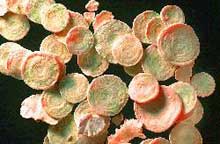Fossils Point the Way to Black Gold

Microfossils <br>(photo: Langer)
Drilling for oil is expensive – and only too often unsuccessful: in 80 to 90 per cent of all attempts the drill head ends up in worthless sediment rather than hitting the black jackpot as intended. In this way, with every unsuccessful drilling, companies squander several million euros. Yet there is an alternative: the use of tiny fossilised single-celled organisms can reveal to the expert where prospecting for oil is worth while, a dying art at which only a few specialists worldwide still remain proficient. A micro-palaeontologist at the University of Bonn is now training specialists in this discipline in conjunction with the firm RWE/DEA.
Some of them look like two-euro pieces made of limestone. For oil companies they can be worth their weight in gold, these unicellular organisms from the foraminifer group. In the sediments of the oceans there are sometimes veritable mass graves of these ancient fossils, which are shaped like round, flat discs or small bulbous lenses, some of them smooth, some provided with bizarre protuberances. What they all have in common is the porous limestone shell with which they are surrounded – and which makes them so important in the search for black gold. The reason for this is that sediments with a high proportion of foraminifers can absorb oil and gas in the porous limestone mantles like an enormous sponge – ideal conditions for the existence of a large deposit.
“Oil is formed when organic material is subjected to pressure and high temperatures, usually at a depth of several kilometres beneath the surface of the land or the ocean bed,” Professor Martin Langer of the Bonn Institute of Palaeontology explains. From there the oil passes through the strata of rock above as if through blotting paper, until it is prevented from rising further, for example by a layer of clay, which acts as a kind of lid. Whether the deposit is likely to yield a lot of oil basically depends – apart from the shape of the “lid” – on the storage capacity of the rock strata involved.
In order to detect this popular energy source the companies carry out a kind of “ultrasonic test” in potentially promising areas: they produce sound waves, monitoring the way they expand and are reflected in the ground by means of geophone recordings. Computers then produce pictures on the basis of the seismic data, which show the pattern of strata in the ground – and on which the trained eye can recognise potential deposits. “However, unfortunately the pictures only have a limited spatial resolution, “ Professor Langer explains. “Firms frequently drill a few hundred yards away from the right location. At the depth indicated they then only find empty rocks.” By means of the microfossils which the drill brings to the surface experts can conclude whether the area really is empty, or whether the drill has simply not yet reached the oil deposits. The fossil finds even enable specialists to find their bearings on the seismic map: by comparing the finds with the strata predicted, the micro-palaeontologist can determine where exactly the drilling should be made or how it needs to be corrected at the second attempt.
“Industrial micro-palaeontology is a venerable art,” Professor Langer adds. “All the large oil prospecting companies used to employ their own fossil experts.” When seismology came along it was thought that the new technology alone would solve the problem. “Since 1980 many micro-palaeontologists have been made redundant, which is why there are so few people to take their place.” Many companies have now realised their error, but there is a shortage of specialists who can provide appropriate training for new micro-palaeontologists. Last spring, for the first time, Professor Langer offered a vocational training course in this long neglected field – and it was a huge success. “We had applicants coming for the two-day course from the US, India and South Africa.”
Worldwide there are only a few institutions in the US and Europe which train micro-palaeontologists for the oil industry. After the successful test run Professor Langer’s aim is now to establish the vocational training course at the University on a long-term basis. “Bonn has a long micro-palaeontological tradition. We have at our disposal one of the largest collections in the world. The chances are good that we could become an international centre for this branch of research, which had almost been consigned to oblivion.”
Media Contact
More Information:
http://www.uni-bonn.de/Aktuelles/Pressemitteilungen/153_02.htmlAll latest news from the category: Process Engineering
This special field revolves around processes for modifying material properties (milling, cooling), composition (filtration, distillation) and type (oxidation, hydration).
Valuable information is available on a broad range of technologies including material separation, laser processes, measuring techniques and robot engineering in addition to testing methods and coating and materials analysis processes.
Newest articles

First-of-its-kind study uses remote sensing to monitor plastic debris in rivers and lakes
Remote sensing creates a cost-effective solution to monitoring plastic pollution. A first-of-its-kind study from researchers at the University of Minnesota Twin Cities shows how remote sensing can help monitor and…

Laser-based artificial neuron mimics nerve cell functions at lightning speed
With a processing speed a billion times faster than nature, chip-based laser neuron could help advance AI tasks such as pattern recognition and sequence prediction. Researchers have developed a laser-based…

Optimising the processing of plastic waste
Just one look in the yellow bin reveals a colourful jumble of different types of plastic. However, the purer and more uniform plastic waste is, the easier it is to…



